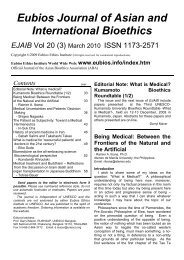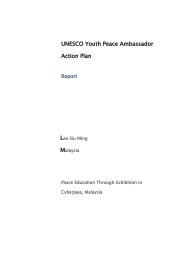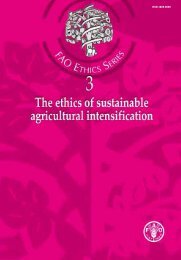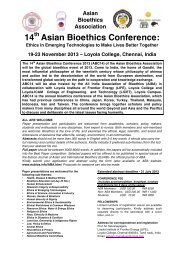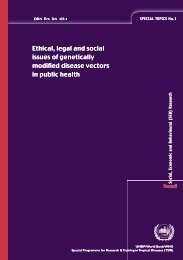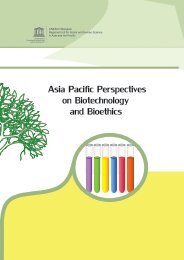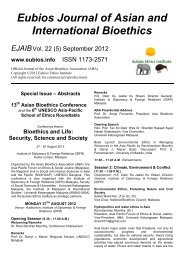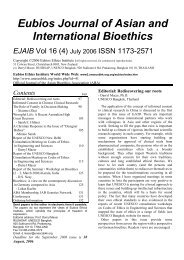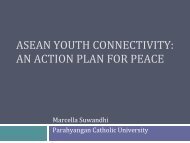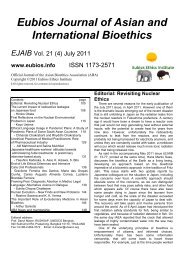Eubios Journal of Asian and International Bioethics EJAIB
Eubios Journal of Asian and International Bioethics EJAIB
Eubios Journal of Asian and International Bioethics EJAIB
- No tags were found...
You also want an ePaper? Increase the reach of your titles
YUMPU automatically turns print PDFs into web optimized ePapers that Google loves.
26<strong>Eubios</strong> <strong>Journal</strong> <strong>of</strong> <strong>Asian</strong> <strong>and</strong> <strong>International</strong> <strong>Bioethics</strong> 18 (January 2008)my view is it an instance <strong>of</strong> another inadequately structuredgovernment policy that needs amendment; it is also a taleabout NIH <strong>and</strong> its fights to guide the conflicting propensity <strong>of</strong>scientific goals, power politics, <strong>and</strong> public ambivalence enroute for entrepreneur finances in the field <strong>of</strong> biomedicalsciences. (Here, power politics is being referred as politicalrelations <strong>and</strong> actions based on an implied threat <strong>of</strong> use <strong>of</strong>political, or economic power by a participant or agent).(3) How Damaging <strong>and</strong> Poorly Prepared Law Can BeAdjusted <strong>and</strong> Modified to Improve National Health <strong>and</strong> Well-Being.This U S Interim Final Rule, as well, reflects the leaningtendency <strong>of</strong> media to overstate issues with under-reporting <strong>of</strong>complex particulars. Such a theatrical <strong>and</strong> acute change inthe policy <strong>of</strong> the U S National Health <strong>of</strong> Institute COI clearlyillustrates the complexity in harmonizing progressive sciencewith the requirements for transparency <strong>of</strong> the entire situation.It may also serve as an obvious instance <strong>of</strong> a law that is notonly damaging but also poorly prepared. It is proposed that itcan be adjusted <strong>and</strong> modified to improve national health <strong>and</strong>welfare. In the present condition, a question may be raisedthat why similar adjustment <strong>and</strong> modification cannot beapplied to both elective abortion <strong>and</strong> fetal/embryonic tissuetransplant research, which is using ES cells.Ethical Concept as it Relates to Bioethical Decision-Making Process.(1) The Concept <strong>of</strong> Moral IntensityIn view <strong>of</strong> the aforementioned circumstances, additionally,after brief discussion in the aforementioned various issuesrelated to the current fetal tissue transplant <strong>and</strong> ES cellresearch, what we can do at present? In order to thoroughlyanswer such a question, the application <strong>of</strong> moral intensitydeserves our immediate attention.The concept <strong>of</strong> Moral Intensity, just as bioethics, is notonly a situation-particular entity, but also to be regarded as anissue-contingent replica <strong>of</strong> ethical decision-making process. Itis founded on the guesswork when the state <strong>of</strong> affairs differswith respect to the moral necessity presented in that situation.This article further explores the position <strong>of</strong> an individual’sdiscernment <strong>of</strong> situation-particular issues on decision-makingin bioethical situations. It does so by applying this concept <strong>of</strong>moral intensity on the bioethical decision-making process. Itevaluates the effect <strong>of</strong> moral intensity on an individual’sdiscernment <strong>of</strong> a bioethical dilemma, along with ensuingmotivations. Moral intensity (Jones, 1991) is defined as theconsideration <strong>of</strong> individual perception <strong>of</strong> ethical situations.While in the context <strong>of</strong> this article, it scopes in the bioethicalsituations.(2) The Application <strong>of</strong> Moral Intensity to Bioethical Decision-MakingKeep in the center <strong>of</strong> thoughts that, as previously beingreferred (vide infra: p. 5-6), most bioethical issues are not onlysituation–particular <strong>and</strong> issue-specific, but also can be viewedfrom different perspectives. Moral intensity proposes thatethical decisions are principally dependent on the apparentdistinctiveness <strong>of</strong> the problem in jeopardy; hence, bioethicaldecision-making entails the communal appraisal <strong>of</strong> thisuniqueness.Moral intensity is frequently employed to study ethicaldecision-making process under different circumstances(Wood, Singhapakdi 1966, Nill, Ohio, Nocera, Nussbaum,Paolillo, Roth, Schibrowsky, Yoo, <strong>and</strong> Dorantes). In brief, thistheory assumes that moral issues can be considered withregard to fundamental distinctiveness that affects the differentphases <strong>of</strong> the decision making process. It is as well noted thatmoral intensity is inherent in any ethically uncertain situation.Jones argues that moral intensity influences ethical-decision–making. He fused prior research from the business <strong>and</strong>marketing field, along with it, the cognitive process togenerate an issue-contingent model <strong>of</strong> ethical decisionmakingthat commence the perception <strong>of</strong> moral intensity.Hence, moral intensity is distinct as the scope <strong>of</strong> issue-relatedmoral crux in a state <strong>of</strong> affairs (Wood). It is founded on thegrounds that the motivation, purpose <strong>and</strong> resulting behaviorstemmed from a person's insight <strong>of</strong> whether a collection <strong>of</strong>ethical mechanisms presents in an underst<strong>and</strong>able <strong>and</strong>discernable environment, <strong>and</strong> to what degree <strong>and</strong> level.Those studies also indicate that relativism negatively affectsone's insight <strong>of</strong> moral intensity (Arrington, <strong>and</strong> Douglas).Conversely, a personal decision is directed by one'sappraisal <strong>of</strong> six dissimilar components that cooperativelycomprise moral intensity <strong>of</strong> the state <strong>of</strong> affairs. Suchmechanisms include 1) magnitude <strong>of</strong> consequences - theaggregate harm or benefits <strong>of</strong> the act; 2) probability <strong>of</strong> effect -the likelihood that the act will cause harm or benefits; 3)temporal immediacy – the length <strong>of</strong> time between the act <strong>and</strong>its consequences; 4) concentration <strong>of</strong> effect – the number <strong>of</strong>people affected by the act; 5) proximity – the social distancebetween the decision maker <strong>and</strong> those affected by the act;<strong>and</strong> 6) social consensus – the degree to which others thinkthe act is good or evil (Jones). There is certainly an influence<strong>of</strong> moral intensity on both ethical intuition <strong>and</strong> behavioralintents, in a context <strong>of</strong> the business <strong>and</strong> marketing.(Singhapakdi, 1966). The more these components that arepresent, the more likely it is that an individual will recognizethe existence <strong>of</strong> an ethical problem, with a subsequent effecton judgment, intentions, <strong>and</strong> behavior (Jones <strong>and</strong> Douglas).Experimental studies in the sector <strong>of</strong> business have alreadyindicated that moral intensity affects perception <strong>of</strong> ethicalissues in general (Jones, Wood, Singhapakdi 1966, Nill, Ohio,Nocera, Nussbaum, Paolillo, Roth, Schibrowsky, Yoo, <strong>and</strong>Dorantes). In parallel, clinical <strong>and</strong> life science researchers, aspreviously indicated, have acknowledged an abundance <strong>of</strong>ethical theory to bear on the moral responsibility <strong>of</strong> their ownresearch. Hence, after presenting the necessity <strong>of</strong> soundunderst<strong>and</strong>ing in moral intensity, this author is proposing amodel, with the hope that such a model will shed light onembryonic/fetal tissue transplantation <strong>and</strong> stem cell research.This proposed model indeed requires the addition <strong>of</strong> theprinciples <strong>of</strong> transparence <strong>and</strong> sensitivity to social <strong>and</strong> culturalsignificance when one is considering the use <strong>of</strong> humanbiological tissue in research endeavors, especially, on the use<strong>of</strong> fetal <strong>and</strong> embryonic tissues for stem cell research. Such amoral stance is in accord with community accountability <strong>and</strong>dependability. The aim <strong>of</strong> this model is to guide the bioethicaldecision-making process.The Model <strong>of</strong> Bioethical Decision-Making ProcessAn individual’s combined evaluation based on these sixcomponents <strong>of</strong> the characteristics results in a given situation’smoral intensity. This affects the individual’s moral judgment,intentions, <strong>and</strong> ensuring decision-making. Basically, problemswith high moral intensity will be identified as ethical dilemmasmore frequent than those with low moral intensity, guiding theway to a positive relationship between moral intensity <strong>and</strong>reorganization <strong>of</strong> ethical problems. Additionally, problems withhigh moral intensity bear a positive relationship with aperson’s intention (motivation) to conduct in an ethicalapproach. Of importance in this context <strong>of</strong> bioethics is the factthat this model does require the participation <strong>of</strong> personalmoral philosophy, <strong>and</strong> that <strong>of</strong> principle <strong>of</strong> transparency <strong>and</strong>sensitivity to the human biological tissues. To elaborate, inaccord with existing ethical theories (Singhapakdi et al., 1996;Singhapakdi et al., 1999), two additional relationships areadded. One is sensitivity to sociocultural significance <strong>of</strong> thehuman biological tissue has a positive relationship towardsreorganization <strong>of</strong> bioethical problems. The other is theprinciple <strong>of</strong> transparency existing between each pair <strong>of</strong>relationships except one, which is the relationship betweenmoral intensity <strong>and</strong> relativism. It is a negative relationship. Allthe aforementioned is indicated in the proposed model in thefigure.



